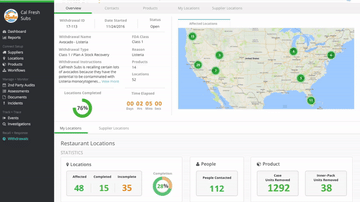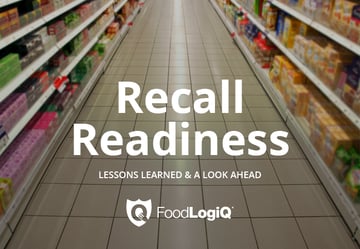 Supply chain disruptions have impacted many industries in recent years, but not all industries are quite as fragile and important as the infant formula industry in the U.S. Infants represent one of the most vulnerable populations in our modern day, which means even the smallest of disruptions in the infant formula market can have detrimental impacts. Unfortunately, the past few years have seen intense shifts, from the pandemic slowing down production, to four separate recalls, and to a war in Ukraine that impacted critical supplies – the formula industry has not been able to catch a break since March 2020.
Supply chain disruptions have impacted many industries in recent years, but not all industries are quite as fragile and important as the infant formula industry in the U.S. Infants represent one of the most vulnerable populations in our modern day, which means even the smallest of disruptions in the infant formula market can have detrimental impacts. Unfortunately, the past few years have seen intense shifts, from the pandemic slowing down production, to four separate recalls, and to a war in Ukraine that impacted critical supplies – the formula industry has not been able to catch a break since March 2020.
While the FDA is working hard to improve the infant formula market after these disruptions, there are lessons that other manufacturers and businesses in the food industry can learn from this experience. In 2018, the romaine lettuce recalls helped emphasize the importance of supply chain transparency efforts as the FDA was eventually able to track impacted products back to their original source. This time, however, there are new lessons to take away. But first, we need a little context into the situation. Let’s break down what went wrong and how businesses can harness these lessons to minimize similar disruptions in the future.
A Timeline of the Infant Formula Events at the FDA (from March 2020 - March 2023)
Through an internal investigation, the FDA released a timeline of the events that lead to the infant formula recalls and shortages in 2021-2022. Here is a summarized timeline of what happened in the past three years:
- March 2020 – Within a few days of the global shutdown due to COVID, the FDA “begins to have concerns” about a shortage of infant formula due to the product being made at a “small number of facilities.” This leads to the FDA submitting a proposal to the national legislature requesting supply chain authority for infant formula and other medical foods.
- September 20-October 6, 2021 – The FDA conducted routine surveillance at a Sturgis, Michigan facility that manufactures about a fifth of the U.S.’s supply of infant formula after a few consumer complaints. The complaints report Cronobacter illness, and the CDC sequenced the samples from the infant formula manufacturers but ultimately did not detect the bacteria in the samples.
- October 21-November 8, 2021 – The FDA received multiple complaints from confidential informants within a few days of each other. The FDA Office of Human and Animal Food Operations (OHAFO) hold meetings to discuss the complaint with the FDA’s Office of Criminal Investigations.
- November 17-December 30, 2021 – A new consumer complaint is issued to the FDA, this time for Salmonella. A few days later, another infant becomes sick from Cronobacter and doesn’t recover. Again, CDC and FDA lab sample tests do not detect Cronobacter or Salmonella in consumer products. The FDA interviews the confidential informant and plans an inspection for January 2022 at the Sturgis facility.
- January 11-February 15, 2022 – The FDA receives a third consumer complaint for Cronobacter. The FDA conducted its inspection at the Sturgis facility, finding several issues related to “sanitation, building, and equipment.” The FDA’s timeline notes: “Seven of the FDA’s environmental swabs suggest the potential presence of Cronobacter.” On February 15, the FDA recommends a voluntary recall from the formula maker.
- February 16-March 18, 2022 – A lot happens in the first few days. More infant illnesses are reported to the FDA, and the FDA officially advises consumers to avoid multiple products made in the facility. Unfortunately, the manufacturer also produced many specialty formulas for infants with metabolic conditions, putting strain on a vulnerable population and limiting supplies. February 24, Russia invades Ukraine, a major producer of sunflower oil, which is a key ingredient in many infant formulas. The FDA meets with other infant formula manufacturers to support increased production to meet demand. By March 18, the FDA closed their inspection at the Sturgis plant.
- April-May 2022 – Production at other facilities picks up to meet the supply chain shortages for infant formula. In late April, product samples of infant formula gathered at the facility show no signs of Salmonella or Cronobacter in formula distributed to consumers. The environmental samples collected by the FDA were from “non-product contact areas” of the facility. After a massive effort to clean and repair the facility lines and building, the Sturgis plant starts making formula again, but warns that it could take two months before products are on the shelf. In response, retailers put limits on how much consumers can buy.
- September 2022 – The FDA holds both an internal and external investigation to determine what internal processes hindered their response to the infant formula shortage and recall.
- January 2023 – The Justice Department Consumer Protection branch begins an investigation into the shutdown of the Sturgis facility.
- February 2023 – The FDA announced major changes: the departure of Frank Yiannas, a shuffling of various functions across the FDA, and the creation of the new Human Foods Program. While not directly caused by the infant formula shortage, the results of the internal and external investigations pushed FDA Commissioner Dr. Robert Califf into advancing these changes sooner than originally planned. Additionally, on February 20, a fourth infant formula recall is issued for possible Cronobacter
- March 2023 – The FDA releases: Immediate National Strategy to Increase the Resiliency of the US Infant Formula Market. The strategy emphasizes the importance of Current Good Manufacturing Practices (CGMP) and includes action items for the FDA, such as:
- Increased inspections of infant formula manufacturing facilities.
- Implement mandatory reporting of potential shortages from producers.
- Developing new models and metrics to monitor and assess market health, including forecasting models and using predictive analytics to determine supply disruptions.
- Create a new Office of Critical Foods, which will be responsible for monitoring infant formula and other medical foods and coordinating any related activities.
- Complete reviews and offer guidance to firms outside the U.S. market looking to sell and be compliant with U.S. infant formula guidelines.
3 Food Safety Lessons for the Food Industry
History is only as important as the lessons we can take away from it, so history doesn’t repeat itself. With that context in mind, here are three major lessons to take away from these events.
Recalls are Going to Become More Common
Four infant formula recalls in a year is certainly cause for concern. And with this scenario, the worst possible outcome was realized as the FDA didn’t react fast enough and infants got sick. In the FDA’s ideal scenario, product recalls would happen before contaminated products would get in the hands of consumers.
However, across the food supply chain, recalls are becoming more common. While consumers may be worried that recalls are happening due to increased contamination, those working within the food industry understand that more frequent recalls are due to increased inspections and protocols in place to catch issues before they can cause illness.
For food manufacturers, this is why it is so vital to optimize your food safety processes. While recalls can be costly, having the right processes and audit-ready documentation in place beforehand can make significant impacts on the financial burden of a recall. And as recalls are very time sensitive, having automated processes to quickly identify and remove products can help minimize the impact on consumers. If you’re considering a solution that can help improve communication, standardize withdrawals, and help your team prepare with mock withdrawals, check out our FoodLogiQ Recall solution.
Be Proactive About Disruptions and Food Safety
Our summarized timeline doesn’t cover all that the Sturgis facility had to face between 2021-2022 – the facility also had several COVID outbreaks, damage from severe weather, and other problems. While 2020 brought many valuable lessons, by far one of the most important is your business will likely fare better if you have contingency plans in place in case the unexpected happens.
Additionally, food safety standards are always changing to improve consumer safety. While Current Good Manufacturing Practices set a great baseline for businesses to maintain operations safely, there are always going to be new threats, challenges, and disruptions that could impact manufacturing capabilities. Instead of hoping for the best and planning for the worst, take a proactive approach to how your facility will respond to disruptions. Consider:
- Do you have contingency plans in place in case you need to switch suppliers?
- If margins are tight, can you cut back on costs without sacrificing safety standards?
- Does your facility regularly communicate safety expectations to employees and suppliers and hold mock recalls?
There are plenty of ways you can bolster safety and proactively prepare your business for disruptions.
The FDA is Pushing for Technological Solutions to Enhance Food Safety Efforts; So Should Food Manufacturers
While the FDA has gone through a lot of changes recently, it’s not taking its focus off the New Era of Food Safety blueprint. Now more than ever, the FDA is focusing on tech-enabled traceability solutions, supply chain monitoring tools, and other ways to infuse technology into the food supply chain to improve consumer safety. In response to the infant formula shortage, they’re even considering machine-learning predictive models to monitor supply disruptions.
All this means that food manufacturers can take the same precautions and invest in solutions that are forward-thinking, flexible, and interoperable across business departments and needs. Trustwell’s suite of Genesis and FoodLogiQ solutions offers just that, with an entire system that connects everything from product formulation to supply chain traceability and optimizing recall processes. If you’re ready to see how our solutions can work for your business, contact our team today to learn more.
Other posts you might be interested in
View All Posts
Food Industry
8 min read
| October 18, 2022
2022 Food Product Recall Trends
Read More
Food Industry
6 min read
| May 18, 2017
FoodLogiQ Disrupts the Food Industry with Market’s First Real-Time Recall Management Solution
Read More
Food Industry
4 min read
| March 13, 2019

